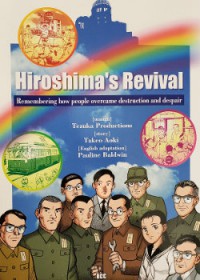Familiar Diversions
I'm a librarian who loves anime, manga, and reading a wide variety of genres.
Currently reading
Hiroshima's Revival: Remembering How People Overcame Destruction and Despair (nonfiction manga) by Takeo Aoki, translated by Pauline Baldwin

This manga begins with a little about Hiroshima's history and then the dropping of the atomic bomb on August 6, 1945. Each chapter covers one aspect of Hiroshima's post-bombing reconstruction and revival.
The first few chapters were dedicated to more immediate reconstruction efforts: restoring electricity, water, and gas (Chapter 1), restarting a streetcar service (Chapter 2), and reopening banks (Chapter 3). The next few chapters dealt with activities that began soon after the bombing and covered more of their history up to the present: getting legal commerce going again in the midst of a thriving black market (Chapter 4), the history of the company now known as Mazda and its three-wheeled truck (Chapter 5), reopening schools (Chapter 6), and getting the municipal government up and running again and acquiring funding for Hiroshima's reconstruction (Chapter 7). The last few chapters felt a bit more removed from the bombing than the rest, but still tied into Hiroshima's overall revival: providing cinema, music, and books to citizens again (Chapter 8), evolving a new local food culture (Chapter 9), and the history of the Hiroshima Carp baseball team (Chapter 10).
I found this volume at a used bookstore and realized, as I was googling it, that it's apparently impossible to buy online - no listings at all for it on Amazon, Barnes & Noble, and AbeBooks, and the book itself didn't include an ISBN or any sort of English-language publisher I recognized. Although the translation generally seemed good, the font choices and text arrangement didn't look very professional, which added to my suspicion that I'd somehow bought a bootleg book. However, I think I've solved the mystery! This review mentions that the English language edition of this work can be purchased in the Hiroshima Peace Museum's shop. Which explains how a few libraries have managed to add it to their collections and makes me feel better about donating it to my own library.
Okay, now on to the content. For the most part, I thought this was a good overview of the Hiroshima reconstruction efforts. I didn't know much about the work that went into it, and the most interesting chapters, for me, were the first three. It amazed me how much folks were able to accomplish only a couple days after the bomb dropped (and I couldn't help but worry about the effect the post-bombing radiation had on those people). I wish I could have learned more about Haruno Horimoto, the girl who volunteered to run the one functional streetcar. The streetcar chapter ended with the closing of the school that was perhaps the only home those girls still had.
The commerce chapter was the weakest and most confusing one in the volume, and seemed less focused on the people involved than the much more effective chapter on reopening the banks that came before it. The second weakest chapter was probably the baseball one, which felt out of place. More than in any other chapter, I could also feel the undercurrents of drama that the author was trying to simplify and smooth over (team management changing repeatedly, the incident with Joe Lutz and the umpire). And I don't know if the bit with the kid donating his allowance to the team actually happened, but it seemed like a particularly in-your-face bit of schmaltz in a volume that was already somewhat prone to playing up sentimental moments and details.
This isn't really something you can go into with the same expectations you'd have for fiction. The dialogue is a bit stilted, for example, and there were times I struggled to tell some of the people apart ("was that one guy with glasses the same guy who spoke up just a few pages ago? oh, yes he was!"). And I wish a bit more care had been put into its lettering - it looked like it was done by someone who hadn't had much experience with it. Dialogue was usually in a Times New Roman-like serif font, while narration was usually in an Arial-like sans-serif font, although occasionally narration used the serif font. And I came to really appreciate the tricks professional letterers use to indicate that text in one panel would be continuing in another, because they were absent in this volume, and it was occasionally jarring to discover that a sentence I had thought might be finished wasn't actually done yet.
Overall, though, I felt this was a really worthwhile and informative read, despite its issues.
Extras:
A postscript with details on some of the overseas efforts to aid Hiroshima's recovery and reconstruction. There's also what appears to be a fairly lengthy bibliography, but all the entries are in Japanese.
Rating Note:
I debated between 3.5 stars and 4. It probably wouldn't have been as much of a debate if I hadn't known, from reading Ichi-F, that this really could have been done better. However, 3.5 stars felt a bit like kicking a puppy - this is such an earnest and heartfelt volume, and I did learn quite a bit from it. And who knew that reopened banks could make me cry? So, 4 stars it is.
(Original review posted on A Library Girl's Familiar Diversions.)













 1
1
 1
1